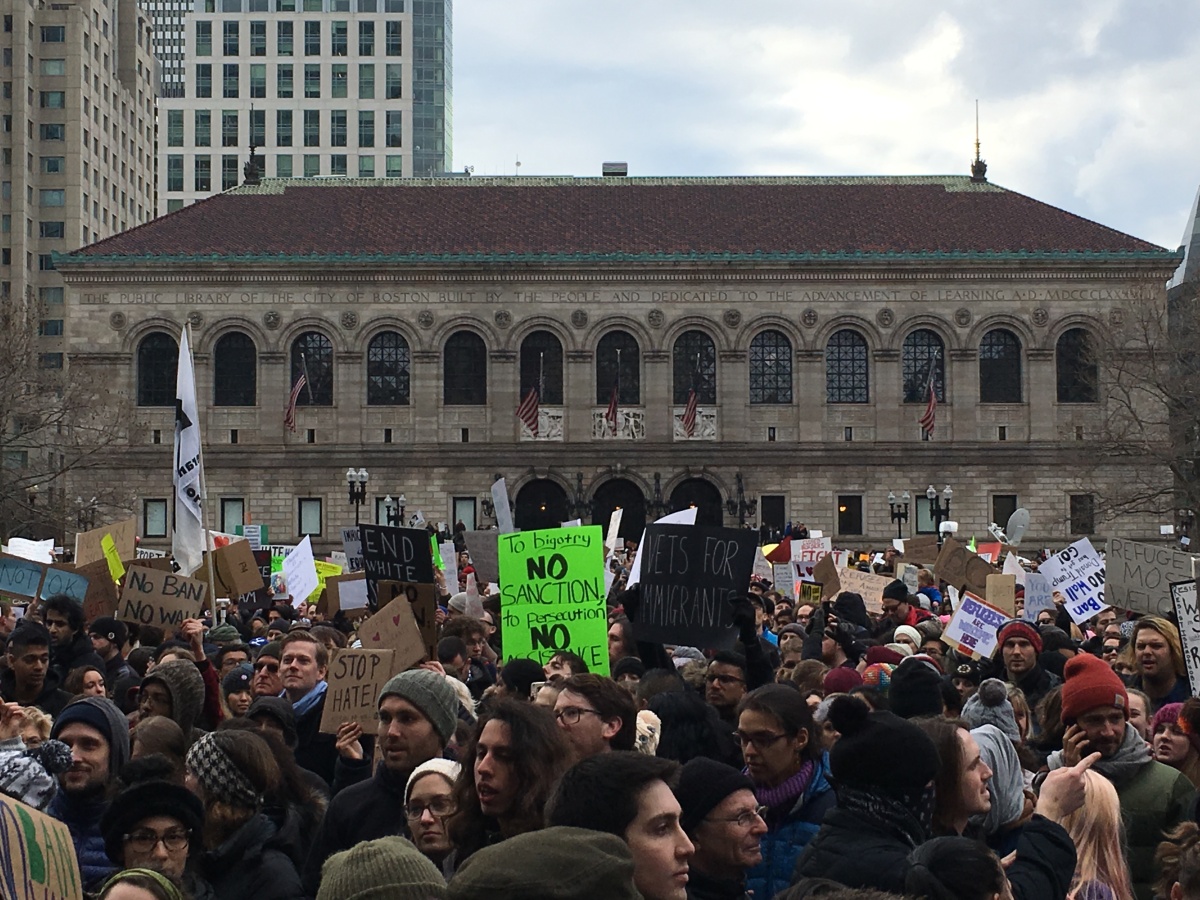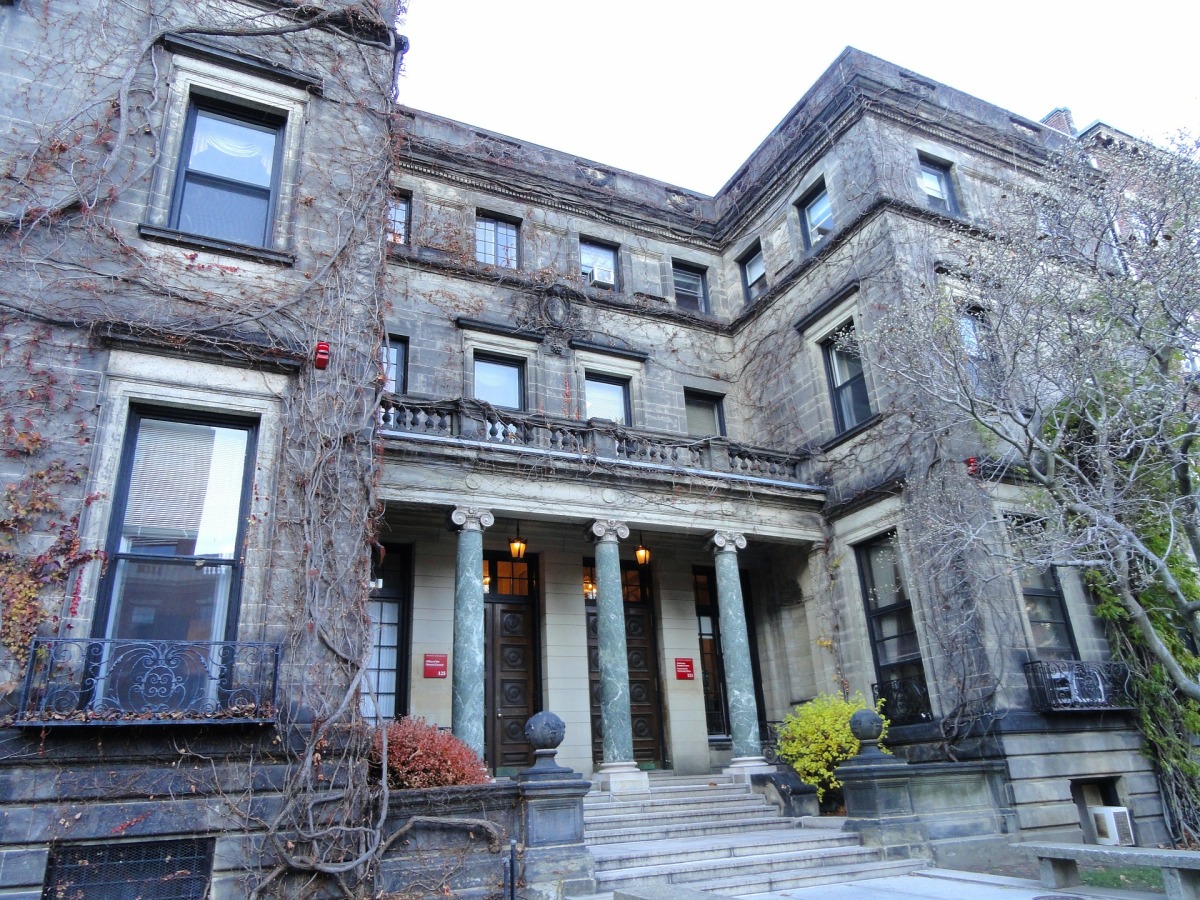In the midst of the controversy over the Trump administration’s executive order barring immigrants and refugees from seven Muslim-majority countries, Attorney General Sally Yates took a largely symbolic stand against the ban, ordering the Justice Department not to defend it in court. What followed was a violent, brusque dismissal that holds echoes of the Saturday Night Massacre.
Month: January 2017
At Copley Square protest, unity and volume in the face of Trump’s unconstitutional travel ban
Thousands took to Copley Square on Sunday to loudly protest the Trump administration’s ban on travelers from seven predominantly Muslim countries in the aftermath of a tumultuous night that saw federal judges from Boston and elsewhere stay parts of the order, which has been disavowed by many key politicians as unconstitutional.
Covering the protest on Twitter meant trying to capture the size and sensation of the protest, as well as individual gestures, protesters, quotes, and political statements made non-verbally. The immediacy of the platform lends itself to such an electric, dynamic setting – but the issues of uploading to Twitter in the midst of a dense crowd, almost all members of which are also online, means that some creativity in where a reporter places themselves is necessary.
Here are some highlights from Twitter, displaying swelling crowds, creative signs, and a prevailing spirit of perseverance.
“No ban, no wall, freedom for all!” – Protestors of Trump’s #MuslimBan easily fill Copley Square. #digiNU pic.twitter.com/QgyTN6LUwE
— Isaac Feldberg (@I_Feldberg) January 29, 2017
“No collaboration with this administration!” – Thousands protest anti-immigration, anti-Muslim ban at Copley Square. #digiNU pic.twitter.com/xQGX5jheCC
— Isaac Feldberg (@I_Feldberg) January 29, 2017
A sign at the Copley Square protest uses Pence’s words against him. “Let them in!” the crowd shouts. #digiNU pic.twitter.com/6VG70jUDO1
— Isaac Feldberg (@I_Feldberg) January 29, 2017
“No justice, no peace!” The Copley Square protest of Trump’s anti-immigrant, anti-Muslim ban swells in both senses of volume. #digiNU pic.twitter.com/cCeIImr0W4
— Isaac Feldberg (@I_Feldberg) January 29, 2017
Thousands still strong in Copley Square, protesting Trump’s anti-immigration, anti-Muslim ban. #DigiNU #MuslimBan pic.twitter.com/ppbURYXWrS
— Isaac Feldberg (@I_Feldberg) January 29, 2017
The mood remains electric two hours in. “THIS IS WHAT AMERICA LOOKS LIKE!” Protesters proclaim in Copley Square. #MuslimBan #DigiNU pic.twitter.com/fwqbloG3ze
— Isaac Feldberg (@I_Feldberg) January 29, 2017
“The people united can never be divided.” John Robbins – CAIR MA, at Copley in protest of Trump’s anti-immigrant #MuslimBan. #digiNU pic.twitter.com/NLQSfgAzcL
— Isaac Feldberg (@I_Feldberg) January 29, 2017
A Cambridge city counselor tells thousands at Copley protesting Trump’s anti-immigration/anti-Muslim ban to “occupy organizing.” #digiNU pic.twitter.com/IfHSIpH0Pq
— Isaac Feldberg (@I_Feldberg) January 29, 2017
As the huddled masses swell, a pair of protesters embrace on church steps in Copley. “No hate, no fear, Muslims are welcome here.” #DigiNU pic.twitter.com/cYEJjxJMw5
— Isaac Feldberg (@I_Feldberg) January 29, 2017
Copley remains stuffed with those protesting Trump’s ban. The volume escalates with the refrain “No ban, no wall.” #DigiNU #MuslimBan pic.twitter.com/H8hUvfAjk4
— Isaac Feldberg (@I_Feldberg) January 29, 2017
“There is nothing Christian about banning Muslims,” a reverend says to the thousands gathering in protest at Copley. #MuslimBan #digiNU pic.twitter.com/kIXC3KuUPA
— Isaac Feldberg (@I_Feldberg) January 29, 2017
“Tear up this ban!” A speaker at Copley Square says of Trump’s anti-immigrant/Muslim ban, to widespread cheers. #digiNU pic.twitter.com/O6N1ExMDUG
— Isaac Feldberg (@I_Feldberg) January 29, 2017
Prayer rugs are laid out at the back edge of the Copley Square protest against Trump’s anti-immigration/Muslim ban. #digiNU #MuslimBan pic.twitter.com/88ypUH4SqU
— Isaac Feldberg (@I_Feldberg) January 29, 2017
“Migration is beautiful,” reads one sign at #MuslimBan protest against Trump’s Islamophobic anti-immigration ban. #digiNU pic.twitter.com/1w0SfRGkos
— Isaac Feldberg (@I_Feldberg) January 29, 2017
The Copley Square protest against #MuslimBan is now mobile, shutting down streets in the direction of Boston Common. #digiNU pic.twitter.com/V8DdxWcQpt
— Isaac Feldberg (@I_Feldberg) January 29, 2017
A fierce warrior against discrimination at Copley, protesting Trump’s unconstitutional #MuslimBan. #digiNU pic.twitter.com/5s8w3x1xVw
— Isaac Feldberg (@I_Feldberg) January 29, 2017
The Copley Square protest against Trump’s xenophobic, Islamophobic #MuslimBan has reached the Common. #digiNU pic.twitter.com/cEoKMYCZGZ
— Isaac Feldberg (@I_Feldberg) January 29, 2017
“No ban, no wall!” Protesters who started at Copley Square are marching against #MuslimBan along the Common. #digiNU pic.twitter.com/DdbpRGrvN4
— Isaac Feldberg (@I_Feldberg) January 29, 2017
“Where is Charlie Baker?” on #MuslimBan rebellion, wonder protesters outside @MAStateHouse. #digiNU #MuslimBanprotest pic.twitter.com/lraaQHjRlP
— Isaac Feldberg (@I_Feldberg) January 29, 2017
#MuslimBan protesters occupy the State House steps, rejecting Trump’s Islamophobic legislation. #NoBanNoWall #digiNU pic.twitter.com/bgZTtcMQXr
— Isaac Feldberg (@I_Feldberg) January 29, 2017
“We gon’ be alright,” protesters chant as #MuslimBan protest continues. #NoBanNoWall https://t.co/iGQArziDSC
— Isaac Feldberg (@I_Feldberg) January 29, 2017
At State House, @titojackson addresses #MuslimBan protesters, promises “organized people” trump “organized money.” #NoBanNoWall #digiNU pic.twitter.com/iORp1qi0Bz
— Isaac Feldberg (@I_Feldberg) January 29, 2017
10 Twitters to follow for college accountability
If you want to keep abreast of what’s going on in the Boston collegiate sphere, you should be on Twitter, following a spread of accounts that serve as platforms for student-run college newspapers and publications. Here are 10 you should be prioritizing.
1. The Huntington News (@HuntNewsNU)
Northeastern University’s independent student newspaper regularly tweets with breaking news on campus in addition to the vast majority of its in-paper and online content.
2. The Daily Free Press (@dailyfreepress)
Boston University’s independent student newspaper is a force on social media, providing breaking news updates, links to its stories, and other avenues for audience engagement.
3. The Harvard Crimson (@thecrimson)
Another active student publication, The Harvard Crimson maintains an active, interactive Twitter account that includes links to its biggest stories.
4. Harvard Magazine (@HarvardMagazine)
An independent voice in the Harvard community and throughout Cambridge, Harvard Magazine regularly discusses the most pressing structural and institutional issues facing Massachusetts’ most famed Ivy League school – and its Twitter is a great way to keep track of the editorials it runs.
5. The Mass Media (@UMBMassMedia)
Though less active than other student newspapers on Twitter, the Mass Media is still relatively timely in its social media presentation, and its perspective on the UMASS Boston community is unique.
6. The Heights (@bcheights)
The independent student newspaper of Boston College, The Heights maintains an active Twitter platform from which it shares the lion’s share of its print content.
7. The Boston Globe (@BostonGlobe)
This should go without saying – the Boston Globe provides better coverage of New England events, including inner-city turmoil and on-campus strife, than any other publication of its size. The Globe reports without any hint of bias on the goings-ons of all Boston institutions and often leads the charge for greater accountability.
8. The Suffolk Journal (@SuffolkJournal)
What the Suffolk Journal lacks in reach, it just about makes up for in specificity. Covering the bulk of news related to Suffolk University, including its major scandals, this paper is an intriguing look inside a less-known city college.
9. The Tech (@thetech)
MIT’s oldest and largest newspaper, as well as an independent one, is a great source of information about MIT and its assorted struggles and victories. In looking to expose the code of silence surrounding student suicide on its campus, The Tech was a trailblazer.
10. The Boston Herald (@bostonherald)
On some select occasions, the Globe will not be first. On those occasions, a good bet is that the Herald, another major New England publication, has scooped its better-known brethren. The Culture section of the Boston Herald is a particularly interesting place to find information about college campuses.
Boston-area colleges fail to embrace “sanctuary campus” movement
The election of Donald J. Trump has sparked nationwide calls by students to designate college campuses as sanctuary locations for the undocumented immigrants he has pledged to deport. And yet, despite advocacy within Boston-area universities aimed at getting colleges to formally declare themselves part of that movement, multiple administrations have proven slow or unwilling to embrace sanctuary status.
At Northeastern, initial demands by students to dub the university a sanctuary campus were met with an email from President Joseph Aoun calling for “unity, inclusion and respect” in response to the election, according to the Huntington News. Student groups like SAID (Students Against Institutional Discrimination) criticized his note as vague and called on him to name Northeastern a sanctuary campus – a demand that as of months later has gone unmet.
The sanctuary campus movement, a mirror of the wider sanctuary city movement that caught fire late last year after Trump’s controversial victory in the election, has called upon institutions of higher learning to label themselves protective environments for undocumented students, workers, and faculty. Such individuals would be impacted by the anti-immigrant policies that constituted a central focus of Trump’s campaign. Sanctuary schools would work to protect undocumented immigrants in their communities from deportations and raids by federal immigration authorities, through refusal to work with such authorities and other forms of active resistance.
In addition to Northeastern, students at Tufts University, UMASS Boston, Harvard University, Boston College, Boston University, MIT, Boston Conservatory, Emmanuel College, MassArt, and Berklee College of Music all signed petitions and held protests calling for their universities to become sanctuaries, according to a crowdsourced map of Boston on Fusion.
Like at Northeastern, student advocates for such designation have been met with lukewarm responses, if any at all.
BU President Robert Brown addressed in December a petition circulated at his school in December that called for a withholding of support for U.S. Immigration and Customs Enforcement, including by prohibiting the agency from entering campus.
“This is not a promise we can make, as the University must obey the applicable state and federal laws,” Brown wrote, as quoted in the Daily Free Press. “I can, however, assure you that the Boston University Police Department does not currently play any role in the enforcement of such laws and will not voluntarily assist the federal government in immigration enforcement.”
Harvard University President Drew Faust rejected the label altogether. “Sanctuary campus status has no legal significance or even clear definition,” Faust said in December, in a statement quoted by The Harvard Crimson. “It offers no actual protection to our students. I worry that in fact it offers false and misleading assurance.”
For many students and faculty, many of whom had backed the movement, Faust’s decision came as a disappointment. Allyson R. Perez, an organizer with Harvard’s Protect Undocumented Students group, spoke to the Crimson about it, calling the choice “extremely frustrating.”
As of press time, none of Boston’s top university administrations have accepted sanctuary status.
Harvard, MIT, Tufts, Boston University, and Northeastern administrators have all spoken in defense of the Deferred Action for Childhood Arrivals (DACA) program, which protects undocumented immigrants who arrived as children. Trump has repeatedly promised to dissolve the program, which was put in place by preceding President Barack Obama.
Temporally subjective visions of news
It’s intriguing to look at the three provided videos (one from 1981, another from 1994, and one more from 2005) and examine how – even before the advent of at-your-fingertips mobile technology platforms and the cultural implementation of the Internet – those in the news industry were accurately predicting many of the conveniences and changes such revolutions would bring about. It seems evident that the importance of ease of access, made possible by virtual newspapers, was lost on no one, and the videos repeatedly touch, presciently so, on readers gaining access to their paper in their homes or on the go without needing to search for a newsstand. The revolutionary tablet technology was also highlighted by the videos, long before the iPad, even with its eventual name. Early on, people were predicting the embrace of customizable technologies, ones with the ability to filter news by type, adjust font size and other visual specifications, and provide access to news on the go. In the 1981 video, those working on taking their newspaper online did not see any massive financial upside to doing so. However, across that and the 1994 video, what’s missing is an appreciation for how dangerous and precedent-setting it would be to provide virtual versions of newspapers without perennial pay-walls or other ways to ensure subscribers/readers aren’t getting for free what had previously been sold. The most predictive of the videos, pertinent to the Museum of Media History, accurately predicts some of the most striking transformations of the media landscape, from the creation of virtually endless online data storage not dissimilar to iCloud or Google Drive, to the surge in “fake news” that a more participatory, public online platform for newsgathering seems conducive to cultivating. It does go a step further to predict massive, sprawling battles between media giants that end in mergers, such as the creation of Googlezon, but (so far) these alliances of necessity have not occurred in such public, striking ways.
On Administrative Accountability
It’s hard out there for a college newspaper. In today’s fast-paced, digitally revolutionized university sphere, information is at every undergraduate’s fingertips – and a cell phone is always closer than a newsstand. With the inexorable decline of print readership comes packaged, for many student papers, diminished interest in funding print journalism, as well as budget cuts for those papers still tied to their respective administrations. Other factors, from fluctuating student interest to administrative interference, compound what feels increasingly like a battle to assert and maintain the basic need for some form of student-run publication.
And yet, despite such significant threats, the importance of a student publication’s role in holding its staff’s administration accountable cannot be dismissed. Publications written by and in part for students serve a key role in establishing active, intersectional dialogue about deeply important subjects that matter not just to students but also to faculty, administrators, prospective enrollees, and the larger communities surrounding inner-city schools. The ability of a student publication to write critically and thoughtfully about the administration with which its staff engages stands in stark contrast to publications maintained by universities, which without fail address only what makes for good press. Maintaining a publication devoted to public discourse, not public relations, is the only way students can reliably rally for accountability and hold their administrations to the highest standards of ethics and legality.
Important issues do manifest on college campuses, which often not unjustly feel like a microcosm of the larger society surrounding them with a diverse array of enrollees, faculty, staff, and administrative officers all adding nuance to one shared community. How institutions engage with (and in some ways perpetuate) such issues as (but not limited to) sexual assault, mental health issues, racial or ethnic discrimination, hate speech, and censorship will always be of keen interest to the student body.
Out of that interest comes the Boston Collegian, a blog devoted to highlighting such campus-specific issues, students’ attempts to spotlight them, and instances in which administrations either support or silence advocates for ameliorating those issues. The blog will cover issues specific to college campuses, utilizing a mix of its own reporting and that of largely or completely independent student newspapers The Huntington News (Northeastern University), The Daily Free Press (Boston University), The Tufts Daily (Tufts University), The Harvard Crimson and Independent (Harvard University), The Tech (MIT), The Suffolk Journal (Suffolk University), The Heights (Boston College), and Mass Media (UMASS Boston).
Photo Courtesy: Unsplash, Creative Commons.




